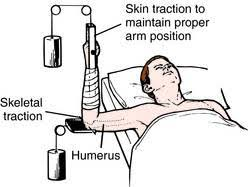A nurse is assessing a client who has a rotator cuff injury. Which of the following findings should the nurse expect?
Difficulty with abduction of the arm at the shoulder.
Alteration in the contour of the joint.
Positive Tinel's sign.
Negative drop arm test.
The Correct Answer is A
Choice A reason:
Difficulty with abduction of the arm at the shoulder is a common finding in clients with a rotator cuff injury. The rotator cuff is a group of muscles and tendons that stabilize the shoulder joint and facilitate its movement. When these muscles or tendons are injured, movements such as lifting the arm away from the body (abduction) can become painful and difficult.
Choice B reason:
Alteration in the contour of the joint is not typically associated with a rotator cuff injury. This finding is more indicative of conditions that cause changes in the bone structure, such as arthritis or dislocation.
Choice C reason:
A positive Tinel's sign is used to diagnose nerve compression or nerve damage, particularly in conditions like carpal tunnel syndrome. It is not a test used to assess rotator cuff injuries.
Choice D reason:
A negative drop arm test would suggest that the client does not have a rotator cuff injury. The drop arm test is performed by having the client lift the arm to 90 degrees and then slowly lower it. If the client can control the motion and lower the arm smoothly, the test is negative. A positive drop arm test, where the client cannot control the descent of the arm, would indicate a rotator cuff injury.
Nursing Test Bank
Naxlex Comprehensive Predictor Exams
Related Questions
Correct Answer is C
Explanation
Choice A reason:
Skin traction is indeed less restrictive than skeletal traction, allowing for more mobility. It is applied using bandages or adhesive material to the skin, which can be removed or adjusted more easily than the pins or screws used in skeletal traction. This type of traction is typically used for short-term treatment before surgery or when the injury is less severe.
Choice B reason:
Discomfort levels can vary depending on the individual and the specific circumstances of the traction. However, skin traction is generally considered to be less painful than skeletal traction because it is less invasive and applies less force. Skeletal traction, which involves the insertion of pins or wires directly into the bone, is likely to cause more discomfort due to the invasive nature of the procedure.
Choice C reason:
Skeletal traction is more appropriate for reducing fractures, especially in cases where a greater force is needed to align the bones. It involves the surgical insertion of pins or wires directly into the bone, allowing for a stronger and more stable pull that is necessary for the realignment of complex fractures.
Choice D reason:
Skeletal traction carries a higher risk of infection compared to skin traction because it is more invasive. The insertion of pins or wires into the bone creates a potential entry point for bacteria, which can lead to infection at the site of insertion.

Correct Answer is A
Explanation
Choice A reason:
The inability to move toes can be an early sign that a cast is too tight. This symptom may indicate that the cast is impinging on nerves or blood vessels, leading to decreased motor function. It is essential to address this immediately to prevent further complications such as permanent damage or compartment syndrome.
Choice B reason:
Edema, or swelling of the toes, can occur if a cast is too tight, but it may not be the first sign observed. Swelling is a response to increased pressure in the tissues and can develop over time as fluid accumulates. While it is a concern, it often follows other symptoms such as changes in sensation or movement.
Choice C reason:
Pallor of the toes, indicating reduced blood flow, can be a sign of a cast that is too tight. However, pallor may not be as immediately noticeable as the inability to move toes or changes in sensation. It is still a critical sign that requires prompt evaluation and possible adjustment of the cast.
Choice D reason:
A change in the temperature of the toes, such as them becoming cooler to the touch, can suggest impaired blood flow due to a tight cast. This sign, along with pallor, may develop after other symptoms such as numbness or motor impairment.
Whether you are a student looking to ace your exams or a practicing nurse seeking to enhance your expertise , our nursing education contents will empower you with the confidence and competence to make a difference in the lives of patients and become a respected leader in the healthcare field.
Visit Naxlex, invest in your future and unlock endless possibilities with our unparalleled nursing education contents today
Report Wrong Answer on the Current Question
Do you disagree with the answer? If yes, what is your expected answer? Explain.
Kindly be descriptive with the issue you are facing.
